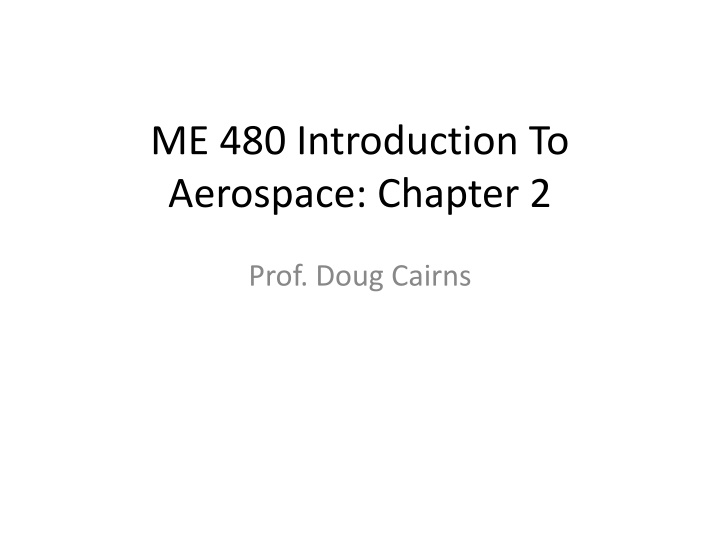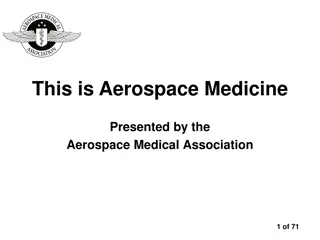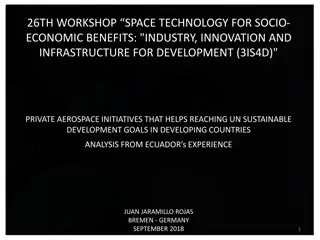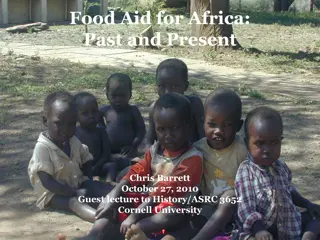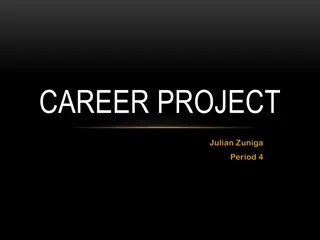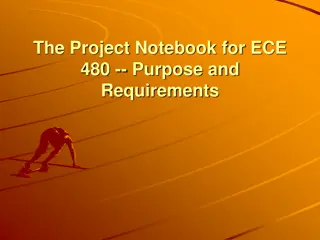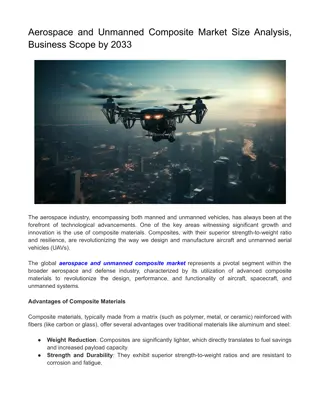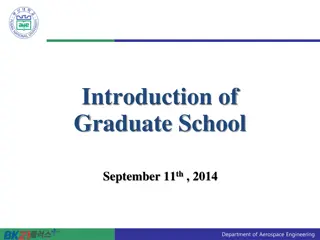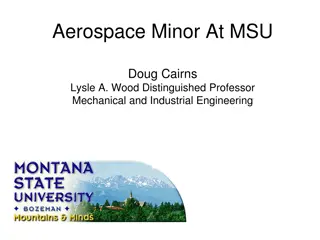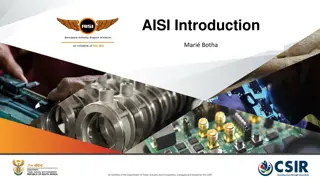ME 480 Introduction To Aerospace: Chapter 2
In this educational material, Prof. Doug Cairns presents fundamental concepts related to aerospace engineering. Topics covered include forces on a body, spatial quantities like pressure and velocity, visualization techniques for fluid dynamics, basic parts and controls of an airplane, and the physics of flight. Furthermore, the content delves into understanding weight in aviation, weight changes during flight, and the components contributing to an aircraft's overall weight. Through insightful images and explanations, this resource provides valuable insights into the principles governing aerospace engineering.
Download Presentation

Please find below an Image/Link to download the presentation.
The content on the website is provided AS IS for your information and personal use only. It may not be sold, licensed, or shared on other websites without obtaining consent from the author.If you encounter any issues during the download, it is possible that the publisher has removed the file from their server.
You are allowed to download the files provided on this website for personal or commercial use, subject to the condition that they are used lawfully. All files are the property of their respective owners.
The content on the website is provided AS IS for your information and personal use only. It may not be sold, licensed, or shared on other websites without obtaining consent from the author.
E N D
Presentation Transcript
ME 480 Introduction To Aerospace: Chapter 2 Prof. Doug Cairns
Spatial Quantities pressure, density, temperature, velocity
Supersonic flow (oil streak used for visualization)
Smoke Injectors to Visualize Streamlines
For the Next Few Slides Basic Physics of Flight What s happening during a flight Rule of Thumb airplane design 2-9
Basic Forces Lift Drag Trim Thrust Weight 2-10
Whats in Weight? Lift Drag Paying Passengers and Cargo Payload Trim Fuel Thrust Weight Reserves Operating items Food, Supplies Airplane Operating Empty Weight (OEW) Systems Navigate, control and support life Propulsion Generate force to move airplane Landing Gear Support airplane on the ground Body Enclose the payload Wing & Tails Provide lift 2-11
Weight changes during the flight. End of flight Start of Flight Payload Burn off fuel Fuel Payload Fuel Reserves Operating items Food, Supplies Systems Navigate, control & support life Operating empty weight Propulsion Generate force to move airplane Landing Gear Support airplane on the ground Body Enclose the payload Wing & Tails Provide lift 2-12
How do you make Lift? Lift Drag Bernoulli: Trim The faster the air flows over the surface, the lower the pressure air exerts on the surface. Thrust Weight 2-13
How to Change Lift Since Lift is about the same as weight and weight changes, then must be able to change lift. Increase lift by increasing the tilt of the wing increasing the speed of the airplane (actually speed squared) decreasing the altitude of the airplane above the ground. 2-14
But there are Limits to Lift Stall The flow no longer can stay attached to the upper surface. Lift Airfoil Tilt Angle 2-15
Ways around the Limits to Lift Slats & Flaps Slats Lift Airfoil Tilt Angle 2-16
Wings are made up of airfoils Wing Airfoil 2-17
How to create Thrust Lift Drag Trim Thrust Weight A propeller produces thrust like a wing produces lift except: The propeller is a wing rotated 90 degrees The speed over the airfoil comes from rotating the prop. 2-18
How does a jet engine produce thrust? Propeller ( compressors ) Propeller ( turbines ) Fuel Burned (Generates high speed air) Thrust A jet engine sucks, squeezes, burns and blows. 2-19
What is Drag? Lift Drag Trim Thrust Weight Due to the influence of an airfoil on those outboard of it Lift and Span Induced Aerodynamic details Due to the rapid growth of the boundary layer Pressure Due to roughness, gaps & antennas Excrescence Smoothness Skin Friction Due to the friction in the boundary layer next to the skin to the air flowing over the skin. Outside surface area 2-20
What & Why Trim? Lift Drag Trim Thrust Weight Trim comes from a wing like surface mounted on the back of the airplane To change the tilt of the airplane increase down load - airplane nose goes up decrease down load - airplane nose goes down 2-21
Airplane Controls Fin Rudder Aileron Elevators Flaps Slats Stabilizer (Tail) Spoilers 2-22
Airplane Stability A stable system A stable airplane Lift Weight Move the ball away from the bottom and it returns to the bottom Move the nose of the airplane up and the airplane s nose will come back down. Because ball s center of gravity is above the bottom of the bucket Because airplane s center of lift is aft of the center of weight 2-23
How does an airplane turn? It banks. Lift Weight 2-24
Why do airplanes have rudders? To balance an inoperative engine and crosswinds. 2-25
Design Envelope Stall Margins Pressurization Engine out takeoff System redundancy Brake Capability Fatigue Flutter Takeoff and Landing Distances Situation Awareness Speed margins Structural Strength margins 2-26
The Plane that Taught America to Fly Note: Dr. Cairns has around 100 hrs in this make and type, over 200 hours in similar type aircraft
We will have an opportunity to crawl around one of These!
The Greatest Fighter Aircraft Ever (according to the Military Channel)
The Funny Looking X29 (forward swept wing for better maneuverability)
